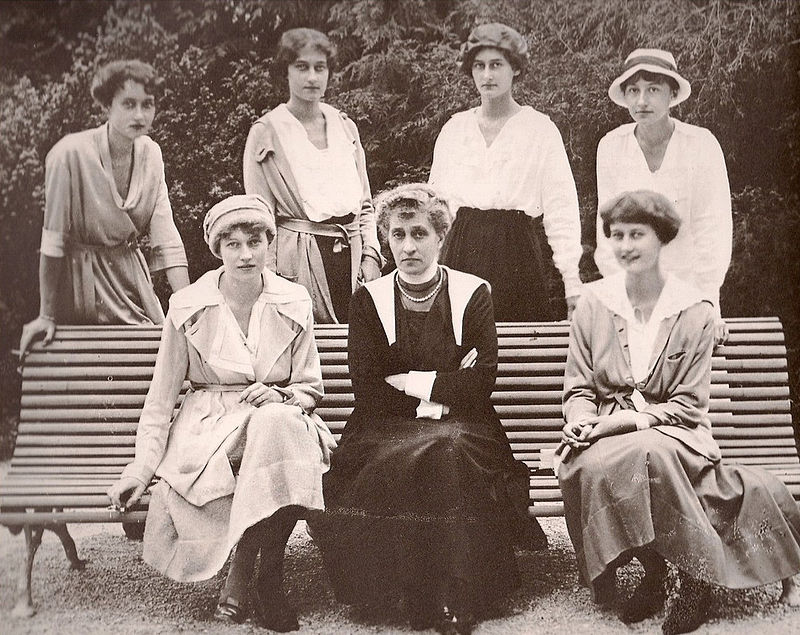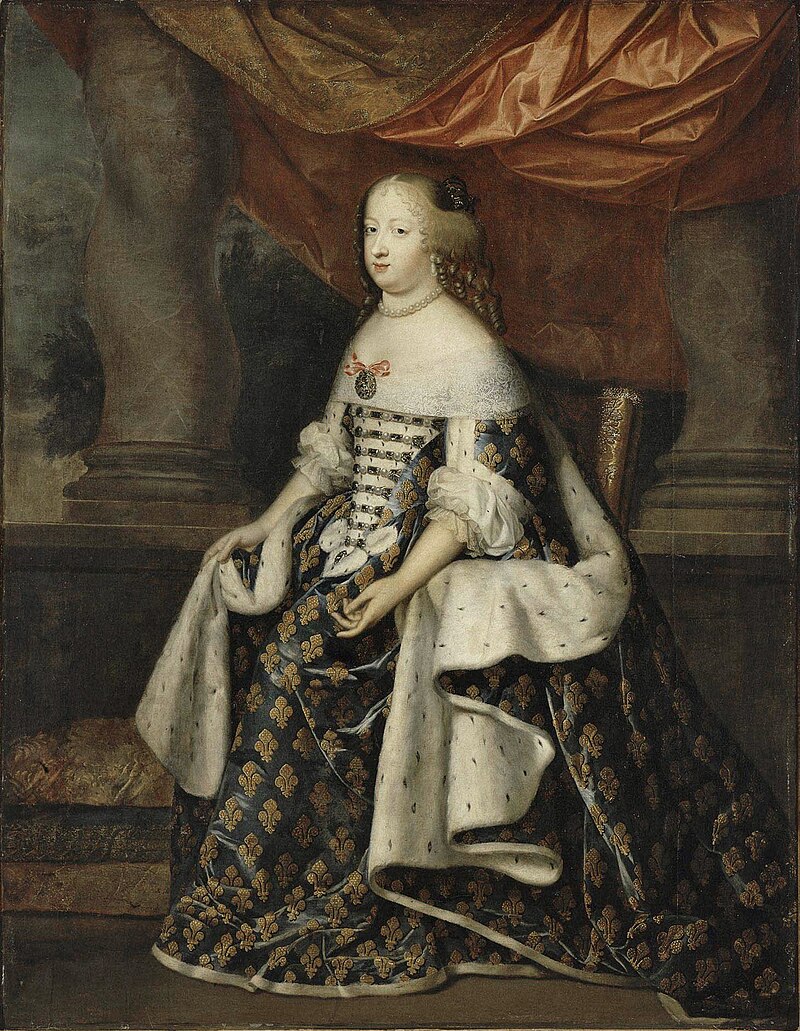© Unofficial Royalty 2024

Maria Ana of Portugal, wife of Grand Duke Guillaume IV of Luxembourg, with her six daughters; Credit – Wikipedia
July 31, 1527 – Birth of Maximilian II, Holy Roman Emperor, King of Bohemia, King of Hungary and Croatia, Archduke of Austria in Vienna, Archduchy of Austria, now in Austria
Maximilian married his first cousin Infanta Maria of Spain, the daughter of his uncle Holy Roman Emperor Charles V, who was also King Carlos I of Spain and Isabella of Portugal. The couple had fifteen children including two Holy Roman Emperors and two Queen Consorts (France and Spain). Upon the death of his father Ferdinand I, Holy Roman Emperor, who was also King of Hungary, Croatia, and Bohemia and Archduke of Austria, Maximilian succeeded as ruler of the Habsburg hereditary lands and was elected Holy Roman Emperor. During his reign, Maximilian had to deal with the ongoing Ottoman-Habsburg wars, conflicts with his Spanish Habsburg cousins, and the effects of the 1555 Peace of Augsburg. The Peace of Augsburg officially ended the religious struggle between Lutherans and Catholics, and made the legal division of Christianity permanent within the Holy Roman Empire, allowing the rulers of the constituent monarchies of the Holy Roman Empire to choose either Lutheranism or Roman Catholicism as the official religion of their state.
Unofficial Royalty: Maximilian II, Holy Roman Emperor, King of Bohemia, King of Hungary and Croatia, Archduke of Austria
July 31, 1750 – Death of King João V of Portugal at Ribeira Palace in Lisbon, Portugal; buried at the Royal Pantheon of the House of Braganza at the Monastery of São Vicente de Fora in Lisbon.
When João was nearly ten years old, his 32-year-old mother Maria Sophia of Neuburg died. His mother’s death caused changes in João’s behavior. He became withdrawn and depressed. His paternal aunt Catherine of Braganza, the widow of King Charles II of England, had returned to Portugal to live in 1693. Catherine took over caring for João and remained his main female role model until she died in 1705. In 1706, João’s father Pedro II, King of Portugal died and his 17-year-old son João became King of Portugal. In 1708, João married Archduchess Maria Anna of Austria, the daughter of Leopold I, Holy Roman Emperor. The couple had six children. In 1742, 52-year-old João had a stroke and became partially paralyzed. He recovered somewhat but was left diminished and much less energetic. His wife Maria Anna served as regent for the rest of his life. After a reign of forty-three years, João V, King of Portugal, aged 60, died on July 31, 1750.
Unofficial Royalty: King João V of Portugal
July 31, 1737 – Birth of Princess Augusta of Wales, Duchess of Brunswick-Wolfenbüttel, daughter of Frederick, Prince of Wales at St. James’ Palace in London, England
Augusta was the elder sister of King George III of the United Kingdom. She married Karl Wilhelm Ferdinand, the future Duke of Brunswick-Wolfenbüttel. The couple had seven children including Caroline who married her first cousin, the future King George IV of the United Kingdom. (The marriage was a disaster.) Augusta never fully adapted to life in Brunswick nor was she well-liked. Any popularity she had was damaged by the fact that her three eldest sons were born with handicaps. Although Augusta reported to her brother King George III that her marriage was happy, it was actually unhappy. Karl found Augusta dull and preferred to spend time with his mistresses. After her husband was killed during the Napoleonic Wars and Brunswick-Wolfenbüttel was occupied by the French, Augusta escaped to Sweden. Her brother King George III sent a British naval ship to transport his sister back home to England. Augusta lived in London with her daughter Caroline, Princess of Wales. Augusta got to know her granddaughter Princess Charlotte of Wales, who told her grandmother upon their first meeting “that she was the merriest old woman she ever saw.” Augusta died on March 23, 1813, at the age of 75.
Unofficial Royalty: Princess Augusta of Wales, Duchess of Brunswick-Wolfenbüttel
July 31, 1769 – Birth of Elizabeth Conyngham, Marchioness Conyngham, Mistress of King George IV of the United Kingdom, born Elizabeth Denison
Elizabeth Conyngham, Marchioness Conyngham was the last mistress of King George IV of the United Kingdom, from 1820 until he died in 1830. George IV was so devoted to her that he bequeathed her his plate and jewels, although she refused them when he died. He also provided housing at Windsor Castle and the Brighton Pavilion for Elizabeth and her family. He ensured that they traveled with him when he moved from one residence to the other. She was given full use of the King’s horses and carriages, and most of the large dinners held at her London townhouse were prepared in the kitchens of St. James’s Palace. To King George IV, nothing was ‘off limits’ for his beloved Elizabeth. However, it would all come to a quick end on the morning of June 26, 1830, when King George IV died at Windsor Castle. By the following day, Elizabeth had packed her belongings and left Windsor for her brother’s home before traveling to Paris, reportedly expelled from the country by the new King William IV.
Unofficial Royalty: Elizabeth Conyngham, Marchioness Conyngham, Mistress of King George IV of the United Kingdom
July 31, 1812 – Birth of Amélie of Leuchtenberg, Empress of Brazil, second wife of Emperor Pedro I of Brazil (King Pedro IV of Portugal), in Milan, Lombardy-Venetia, now in Italy
Full name: Amélie Auguste Eugénie
Amélie was the daughter of Eugène de Beauharnais (son of Empress Jospéhine, the first wife of Napoleon I, Emperor of the French, from her first marriage) and Princess Augusta of Bavaria. Because of a political and economic crisis, her husband Emperor Pedro I of Brazil abdicated his throne in favor of a daughter from his first marriage. Pedro, Amélie, and their daughter Maria Amélie returned to Portugal. Both Pedro and his daughter Maria Amélie died from tuberculosis. Amélie financed the construction of a hospital to treat patients with lung diseases in Funchal on the island of Madeira in Portugal called the Hospício da Princesa Dona Maria Amélie which is still in existence. When Amélie died, the Hospício da Princesa Dona Maria Amélia was handed over to her sister Queen Joséphine of Sweden, and according to the terms of Amélie’s will, it is owned and administered by the Swedish Royal Family. King Carl XVI Gustaf, Queen Silvia, and Crown Princess Victoria of Sweden have visited the hospital.
Unofficial Royalty: Amélie of Leuchtenberg, Empress of Brazil
July 31, 1816 – Birth of Maria Theresa of Austria, Queen of the Two Sicilies, second wife of Ferdinando II, King of the Two Sicilies, at Weilburg Castle near Vienna, Austria
Full name: Maria Theresia Isabella
In 1836, Maria Cristina of Savoy, Queen of the Two Sicilies, wife of Ferdinando II, King of the Two Sicilies died at the age of 23 from childbirth complications after giving birth to a son. The widowed king met Maria Theresa during his stay in Vienna, Austria later in 1836, and they became engaged to strengthen the relations between Austria and the Two Sicilies and married in 1837. Maria Cristina and Ferdinando had twelve children. Ferdinando died in 1859 at the age of 49 after hesitating to have surgery for a strangulated hernia. During Ferdinando II’s reign, the Italian unification movement led by Vittorio Emanuele II, King of Sardinia, later Vittorio Emanuele I, King of Italy, and Giuseppe Garibaldi, a noted general and politician, began. During the reign of Ferdinando’s son Francesco II, Giuseppe Garibaldi’s 1860-1861 invasion called the Expedition of the Thousand led to the fall of the Kingdom of the Two Sicilies, which then was annexed to the new Kingdom of Italy in 1861. Maria Theresa and her children left Naples and settled in Rome. In the summer of 1867, a cholera epidemic broke out in Rome. Both Maria Theresa and her youngest son, ten-year-old Gennaro developed cholera and died from the disease.
Unofficial Royalty: Maria Theresa of Austria, Queen of the Two Sicilies
July 31, 1924 – Death of Prince Franz Joseph of Battenberg, son of Prince Alexander of Hesse and by Rhine, in Territet, Switzerland; buried in the Schaffhausen Forest Cemetery in Schaffhausen, Switzerland
The Battenberg/Mountbatten family descends from Franz Joseph’s parents Prince Alexander of Hesse and by the Rhine and his morganatic wife Countess Julia von Hauke. Franz Joseph married Princess Anna of Montenegro but the couple did not have children. During World War I, they found their financial situation more and more precarious and sometimes struggled to make ends meet. After 1920, they began to receive some financial support from Edwina Mountbatten, the wife of Franz Joseph’s nephew Louis Mountbatten, the future 1st Earl Mountbatten of Burma. Until her death in 1960, Edwina continued to send money to Princess Anna. Prince Franz Joseph outlived all of his siblings.
Unofficial Royalty: Prince Franz Joseph of Battenberg
July 31, 1942 – Death of Maria Ana of Portugal, Grand Duchess of Luxembourg, wife of Grand Duke Guillaume IV of Luxembourg, in exile during World War II in New York City; temporarily interred at Calvary Cemetery in Queens in New York City and then buried at the Notre-Dame Cathedral in Luxembourg after World War II
Maria Ana married Guillaume, the future Grand Duke of Luxembourg. The couple had six daughters including two reigning Grand Duchesses of Luxembourg. Maria Ana fled Luxembourg with her family when the German Army invaded in 1940. She died in New York City on July 31, 1942, of a stomach ailment and was temporarily interred at Calvary Cemetery in Queens in New York City. Her remains were later returned to Luxembourg and buried at the Cathedral of Notre Dame in Luxembourg City, Luxembourg.
Unofficial Royalty: Maria Ana of Portugal, Grand Duchess of Luxembourg
July 31, 1993 – Death of Baudouin I, King of the Belgians in the Villa Astrida in Motril, Spain; buried at the Church of Our Lady in Laeken, Brussels, Belgium
On July 31, 1993, King Bauduin died at Villa Astrida, his private retreat in Motril, Spain. Although King Baudouin had heart surgery in March 1992, his death from heart failure still came unexpectedly and sent Belgium into a period of deep mourning. He was succeeded by his brother King Albert II, who would reign for the next 20 years until he abdicated in favor of his son Philippe. Baudouin’s funeral was held at the Cathedral of St Michael and St Gudula in Brussels, Belgium, and attended by many royals from around the world. One notable guest was Queen Elizabeth II of the United Kingdom, who rarely attended royal funerals. Following the funeral, King Baudouin’s remains were entombed in the Royal Crypt at the Church of Our Lady of Laeken, the traditional burial site of the Belgian monarchs.
Unofficial Royalty: King Baudouin I of the Belgians
This article is the intellectual property of Unofficial Royalty and is NOT TO BE COPIED, EDITED, OR POSTED IN ANY FORM ON ANOTHER WEBSITE under any circumstances. It is permissible to use a link that directs to Unofficial Royalty.









